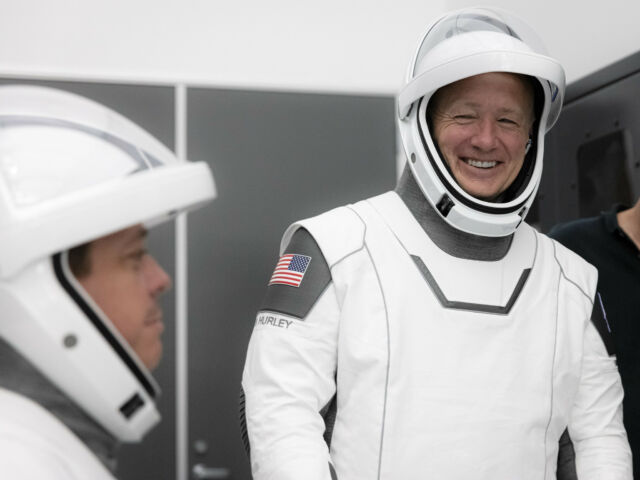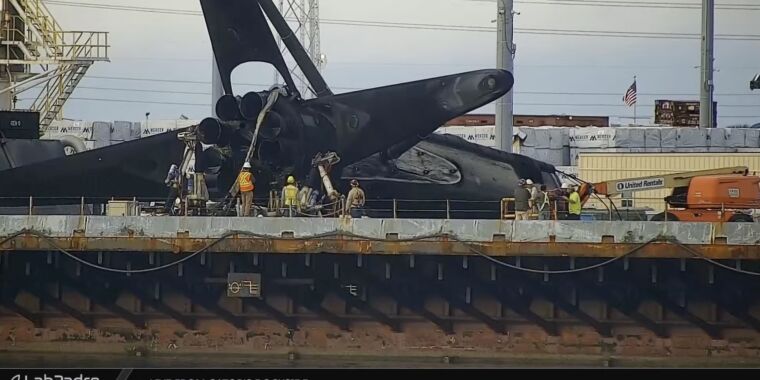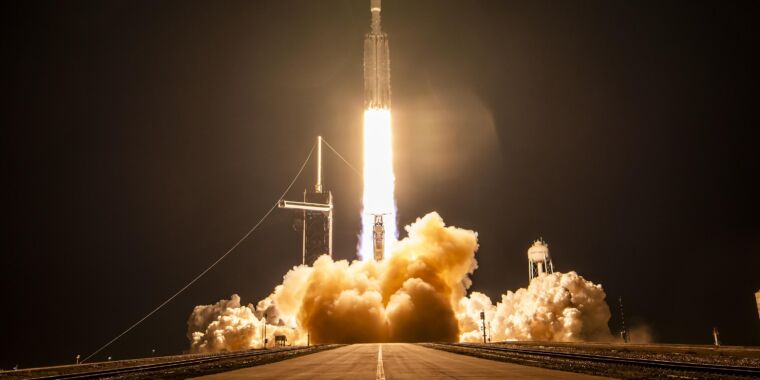A commander’s lament on the loss of a historic SpaceX rocket
Museum piece —
This rocket restored NASA crew launches to US soil, then launched 18 more times.

Enlarge / One of the most historic rockets in SpaceX’s fleet toppled over Christmas Day on the return trip to Cape Canaveral, Florida, following its previous mission.
The Falcon 9 rocket that launched NASA astronauts Doug Hurley and Bob Behnken on SpaceX’s first crew mission in 2020 launched and landed for the 19th and final time just before Christmas, then tipped over on its recovery ship during the trip back to Cape Canaveral, Florida.
This particular booster, known by the tail number B1058, was special among SpaceX’s fleet of reusable rockets. It was the fleet leader, having tallied 19 missions over the course of more than three-and-a-half years. More importantly, it was the rocket that thundered into space on May 30, 2020, on a flight that made history on several counts.
It was the first time a commercial rocket and spacecraft launched people into orbit, and ended a nine-year gap in America’s ability to send astronauts into orbit from US soil, following the retirement of the space shuttle. This mission, known as Demo-2 and launched by SpaceX under contract with NASA, ended US reliance on Russian rockets to send crews to the International Space Station.
SpaceX recovered the booster on one of its offshore landing platforms after the historic launch in May 2020, while the Falcon 9’s upper stage fired into orbit with the Crew Dragon spacecraft containing Hurley and Behnken. Then, the rocket went into SpaceX’s fleet rotation to launch 18 more times, primarily on missions to deploy Starlink Internet satellites.
Hurley, who commanded the Crew Dragon spacecraft on the Demo-2 mission, kept up with the booster’s exploits well after his return to Earth. He regularly exchanged text messages with Behnken and Kiko Dontchev, SpaceX’s vice president of launch, as the rocket just kept flying.
“For Bob and I, that particular booster was always pretty special for a lot of reasons,” said Hurley, a veteran Marine Corps fighter pilot who retired from NASA’s astronaut corps in 2021. He now works at Northrop Grumman.
An inauspicious ending
Hurley told Ars he would like to see the booster’s remains displayed in a museum alongside the Crew Dragon spacecraft (named Endeavour) he and Behnken flew in 2020. “In a perfect world, I’d love to see Endeavour and at least now part of that booster in the Smithsonian or in a museum somewhere,” he said.
“It’s kind of a bummer,” Hurley told Ars. But he understands SpaceX got a lot of use out of this rocket. SpaceX also has a lot of love for Hurley and Behnken. The company named two of its recovery ships for payload fairings “Bob” and “Doug” after the astronaut duo.
“SpaceX has got a business to run,” he said. “I think, at this point, certainly Endeavour is going to fly more, but this booster isn’t, so hopefully they can find a spot to display it somewhere. Even part of it would look kind of cool somewhere. They could figure something out … People, I think, can get a lot of inspiration from seeing stuff that’s actually flown in space, and being able to get right up close to it, I think, is a big deal to a lot of people.”

Enlarge / Doug Hurley, right, commanded the Crew Dragon spacecraft on the Demo-2 mission in 2020.
NASA
The 19th launch of this booster on December 23 was just as successful as the previous 18, with a smooth climb into space before shutting down its nine kerosene-fueled Merlin engines. The booster coasted to the highest point in its trajectory—72 miles (116 kilometers)—before Earth’s gravity pulled it back into the atmosphere.
Two engine burns slowed the rocket as it descended toward SpaceX’s drone ship positioned near the Bahamas, and then four carbon-fiber legs deployed moments before an on-target touchdown. Then, as usual, the recovery vessel started its slow journey back to Florida with the 15-story-tall booster standing vertically.
A commander’s lament on the loss of a historic SpaceX rocket Read More »


